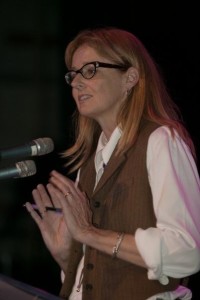
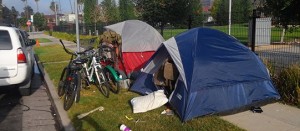
Anyway, as usual, we’re going to mock this nonsense one piece at a time, with Kerry’s words in blue. The links are Kerry’s.

Of his bones are coral made;
Those are pearls that were his eyes;
Nothing of him that doth fade,
But doth suffer a sea-change
Into something rich and strange.
Sea-nymphs hourly ring his knell:
Ding-dong.
Hark! now I hear them — Ding-dong, bell.
We’ll give her the first sentence. It’s even possible that it’s true that complaints about homeless people have dominated her attention. We’ll even give her the tacit condescension of a link to Wiktionary paired with the awkward little “of sorts” surrounding Ariel’s beautiful and much abused notion of a sea change. But pay close attention to her claim that what we are seeing does not resemble the face of homelessness five or ten years ago. Surely we’re going to see some evidence for this!
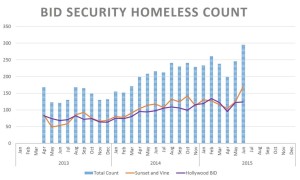

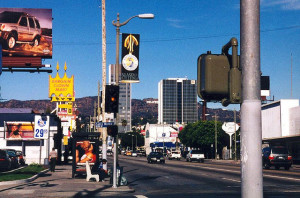
For years, in Hollywood, we recognized those who were chronically homeless in Hollywood and by 2010, we worked very hard to identify everyone by name. That allowed the members of our coalition, Hollywood 4WRD, to intentionally connect over 400 people to housing options over five years. We were making great progress as a coalition.
She means to say that she imagined that they were making great progress as a coalition. There’s no evidence. The chart only goes back to 2013 and tells us that in April of that year there were about 160 homeless people in the two BIDs. If Kerry’s little group housed 400 people by 2010 and they were truly making progress, we’d expect there to have been about 560 homeless people at some point before 2010. If that’s the case, then why all the fuss about there being 295 in June 2015? That would be a 47% DECREASE. If such a thing had occurred, we suppose Kerry’d have been touting it here. That she’s not suggests that it did not occur. If it did not occur, where does she get the idea that anyone was making progress?
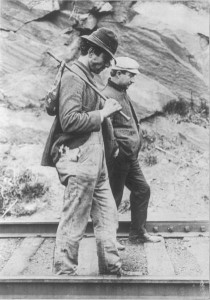
Kerry, this is anecdata. You’re just imagining this. There’s no reason to believe that there’s any kind of change, sea or otherwise. If you have data, let’s see it. OH! I see, you noticed the “sea change” and then you set out to collect some data to prove that it exists! First cherry-picking, and now confirmation bias:
In May, I asked our BID Patrol to engage every new face they saw and ask three questions:
1. Where were you one year ago?
2. Why are you in Hollywood?
3. What are your needs?
In the first month, there was a startling realization: 55% of the 36 new faces in Hollywood said that one year ago, they were in another state. (20/36)
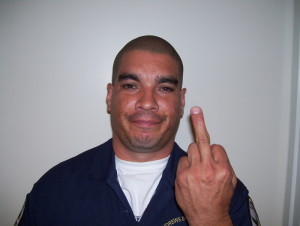
To test whether this was an aberration, I asked the BID patrol to continue these intercept interviews for two more months. And further, our BID Security Committee asked if we could add a fourth question to the short interview: “What is your substance of choice?”
Don’t change the survey in the middle of the study! There’s already every reason to suspect that people would lie to your survey-takers. If now all of a sudden you’re asking them about drug use, they have even more reason to lie. Not only does adding this question make the survey results even more suspect, adding it in the middle of the study makes the results completely incomparable to the previous set of results.
On July 30, 2015, our team had conducted these brief interviews with 113 new faces over three months.
Is 113 enough people to make the survey statistically relevant? Is it a representative sample? There’s absolutely no way to tell, and sampling is HARD to get right. People write entire doctoral dissertations on survey methodology. It’s really not the kind of thing one can just imagine into being like this, not if meaningful information is to come of it.
Here is a summary of the key findings:
•72 percent were male
And what is this compared to?
•Two out of three were under age 35
And what is this compared to?
•One year ago, 44 percent were in another state
It’s very hard to see what this might mean. For instance, look at Kerry’s chart. It seems to show about 210 homeless people in the BID in May 2014 and about 245 in May 2015. This is about a 16% increase. If 44% were in another state one year prior to May 2015, then there must have been significantly many homeless people leaving in order for the increase to be only 16%. Is there any way to measure this effect? We don’t know, but we do know that if it’s not accounted for there’s really no way to draw conclusions from these numbers.
•One year ago, 63 percent were homeless (which means that 27 percent were not homeless)
Kerry! 63+27=90. Actually it means that 37 percent were not homeless. Yet another reason not to leave statistics to the amateurs.
•57 percent admitted to some substance use. Crystal meth, heroin and marijuana were more prevalent among the younger cohort; alcohol the preferred substance for the older
So a guy dressed like a cop, who has almost certainly arrested the subject or friends of the subject, asks what drugs do they use and we’re to expect that the truth is forthcoming? That the truth was not forthcoming is suggested by the fact that according to the federal Substance Abuse and Mental Health Agency, in 2013 66.3% of people 12 years old or older admitted to using alcohol within the previous year. Once 12-17 year olds are excluded, this number goes up to over 80%. So, not even counting drugs other than alcohol, what Kerry has managed to demonstrate here, if anything, is that the homeless of Hollywood are significantly more abstemious than the general population of the United States. Kerry is famous for her theory that giving money directly to homeless people makes them into drunkards, but the evidence here at least suggests that that’s not the case.

•16 people (14 %) expressed some desire for help
Let’s be very clear here. 16 people expressed some desire for help from the armed, violent, threatening, BID Patrol officer standing before them. It’s pretty likely that a lot of people who want help don’t want it from the BID Patrol.
Two factors emerge from these results which raise concerns as to whether our coalition partners can make meaningful inroads into helping people off the street:
1. If 40 (minimum) new people are arriving every three months and are newly homeless in Hollywood, we are never going to meaningfully impact homelessness in Hollywood.
Where does this 40 people every three months come from? Even using Kerry’s cherry-picked worst case scenario from June 2013 to June 2015, a span of 24 months, she’s claiming an increase of 320 people, when even her suspect data shows an increase of only about 270. Other periods of time show even smaller increases. We don’t know if her creepy business-friendly “coalition,” Hollywood 4wrd, is ever going to “meaningfully impact homelessness in Hollywood,” but we do know that with faulty data like this we’re not likely to find out.
2. If more than fifty percent are struggling with substance abuse, this raises the risk of intermittent homelessness becoming chronic, and the risk of a potential increase in property crimes.
First of all, “admitt[ing] to some substance use” is absolutely not the same as “struggling with substance abuse”. Second of all, people on the BID Board of directors drink as much or more than most homeless people. Conflating drug use with drug abuse is bad enough. Equating it with crime is ridiculous and hypocritical. Oh, BIDs, look to the beam in your own eyes, why don’t you? Ask your board members about their substances of choice. Use the data to draw conclusions about how drinking thousand dollar bottles of French wine leads to rampant criminal behavior by BID Board members. Moan and clutch your pearls about alcohol use and white collar crime. Anyway, your own data shows that the Hollywood homeless drink less than the average population. We might even celebrate this fact if the data were even minimally reliable.
This blog post is intended to be descriptive at this moment, not prescriptive. We need to determine if similar trends are surfacing elsewhere in Los Angeles. I would welcome a more academic approach to this simple BID Patrol intercept survey.
On your behalf we asked an academic to read your blog post. Her advice? Hire a professional, and she’d flunk and humiliate you if you were in her Sociology 101 class.
There’s more in Kerry’s blog post, but this is already too much for us. We’re outta here, and Kerry? Don’t quit your day job, whatever it is.
Image of Kerry Morrison in a vest is a California public record and therefore in the public domain. Same deal with the photo of tents. Edmund Dulac’s lovely illustration of William Shakespeare’s lovely play, The Tempest, is in the public domain due to having been made in 1908. The super-slick looking bar graph is a California public record and is therefore in the public domain. Image of cherry picking is released under the CC BY 2.0 and is available via Wikimedia. Image of Santa Monica and Vine is released under the CC BY-NC-ND 2.0 by its creator R Bass and it is available via Flickr. Image of hobos is public domain according to Wikimedia, where we got it. The two images of BID Patrollies flipping people off are in the public domain as we obtained them from the HPOA via the California Public Records Act.
